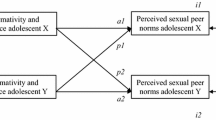Abstract
Young people's understanding of sexual coercion was studied. Boys and girls (N = 191) were asked to rate scenarios depicting sexual situations according to their perceptions of communicative clarity, the extent of pressure being applied to one partner, and the acceptability of the behaviors. Judgments of communicative clarity were given more readily when there was consent rather than dissent to sex. Clear communication was readily inferred even when there were no cues that this was the case. Boundaries of behaviors that were defined as constituting “pressure” were influenced by the outcome, that is whether sex did or did not occur, as well as the behavior itself. Ratings of acceptability closely followed those of pressure, although the relationships between perceptions of pressure and acceptability were stronger for girls than for boys. In general, there were few gender differences in perceptions of pressure and communicative clarity. Of concern was the finding that, for some respondents, pressure and acceptability were unrelated to the use of either physical or emotional force.
Similar content being viewed by others
REFERENCES
Abbey, A. (1982). Sex differences in attributions for friendly behavior: Do males misperceive females' friendliness? J. Pers. Soc. Psychol. 42: 830–838.
Abbey, A. (1987). Misperceptions of friendly behavior as sexual interest: A survey of naturally occurring incidents. Psychol. Women Quart. 11: 173–194.
Abbey, A., and Melby, C. (1986). The effects of nonverbal cues on gender differences in perceptions of sexual intent. Sex Roles 15: 283–298.
Beaver, E. D., Gold, S. R., and Prisko, A. G. (1992). Priming macho attitudes and emotions. J. Interpers. Violence. 7: 321–333.
Buzwell, S. (1996). Constructing a sexual self. Doctoral dissertation, La Trobe University, Melbourne, Australia.
Buzwell, S., Rosenthal, D. A., and Moore, S. M. (1992). Idealising the sexual experience. Youth Stud. Aust. 3: 10
Craig, M. E. (1990). Coercive sexuality in dating relationships: A situational model. Clin. Psychol. Rev. 10: 395–423.
Craig Shea, M. E. (1993). The effects of selective evaluation on the perception of female cues in sexually coercive and noncoercive males. Arch. Sex. Behav. 22: 415–433.
Davis, T. C., Peck, G. Q., and Storment, J. M. (1993). Acquaintance rape and the high school student. J. Adolescent Health Care 12: 220–224.
Erikson, P., and Rapkin, A. (1991). Unwanted sexual experiences among middle and high school youth. J. Adolescent Health 12: 319–325.
Feltey, K. M., Ainslie, J. J., and Gibb, A. (1991). Sexual coercion attitudes among high schools students: The influence of gender and rape education. Youth Soc. 23: 229–250.
Gavey, N. J. (1991). Sexual victimization among New Zealand university students. J. Consult. Clin. Psychol. 59: 464–466.
Gavey, N. J. (1992). Technologies and effects of heterosexual coercion. Fem. Psychol. 2: 325–351.
Holland, J., Ramazanoglu, C., Sharpe, S., and Thomson, R. (1991a). Pressured Pleasure: Young Women and the Negotiation of Sexual Boundaries, The Women's Risk AIDS Project, Paper No. 7, Tufnell Press, London.
Holland, J., Ramazanoglu, C., Scott, S., Sharpe, S., and Thomson, R. (1991b). Presure, Resistance and Empowerment: Young Women and the Negotiation of Safer Sex, The Women's Risk AIDS Project, Paper No. 6, Tufnell Press, London.
Holland, J., Ramazanoglu, C., Scott, S., Sharpe, S., and Thomson, R. (1992). Risk, power and the possibility of pleasure: Young women and safer sex. AIDS Care 4: 273–283.
Hollway W. (1984). Gender difference and the production of subjectivity. In Henriquwa, J., Hollway, W., Urwin, C. Venn, C., and Walkerdine, V. (eds.), Changing the Subject: Psychology, Social Regulation and Subjectivity, Methuen, London, pp. 227–263.
Kelly, L. (1987). The continuum of sexual violence. In Hammer, J., and Maynard, M. (eds.), Women, Violence and Social Control, Macmillan, London, pp. 46–60.
Koss, M. P., Gidycz, C. A., and Wisniewski, N. (1987). The scope of rape: Incidence and prevalence of sexual aggression and victimization. J. Consult. Clin. Psychol. 50: 455–457.
Koss, M. P., and Oris, C. J. (1982). The Sexual Experience Survey: A research instrument investigating sexual aggression and victimization. J. Consult. Clin. Psychol. 57: 455–457.
Moore, S. M., and Rosenthal, D. A. (1993). Sexuality in Adolescence, Routledge, London.
Muehlenhard, C. L. (1988). Misinterpreted dating behaviors and the risk of date rape. J. Soc. Clin. Psychol. 6: 20–37.
Muehlenhard, C. L., Goggins, M. F., Jones, J. M., and Satterfield, A. T. (1991). Sexual violence and coercion in close relationships. In McKinney, K., and Sprecher, S. (eds.), Sexuality in Close Relationships, Erlbaum, Hillsdale, NJ, pp. 155–175.
Muehlenhard, C. L. and Linton, M. A. (1987). Date rape and sexual aggression in dating situations: Incidence and risk factors. J. Counsel. Psychol. 34: 186–196.
Patton, W., and Mannison, M. (1995). Sexual coercion in dating situations among university students: Preliminary Australian data. Aust. J. Psychol. 47: 66–72.
Richardson, D. R., and Hammock, G. S. (1991). Alcohol and acquaintance rape. In Parrot, A., and Bechhofer, L. (eds.), Acquaintance Rape: The Hidden Crime, Wiley, New York, pp. 83–95.
Rosenthal, D. A., and Peart, R. (1996). The rules of the game: Teenagers communicating about sex. J. Adolescence 19: 321–332.
Shotland, R. L., and Goodstein, L. (1992). Sexual precedence reduces the perceived legitimacy of sexual refusal: An examination of attributions concerning date rape and consensual sex. Pers. Soc. Psychol. Bull. 18: 755–764.
Author information
Authors and Affiliations
Rights and permissions
About this article
Cite this article
Rosenthal, D.A. Understanding Sexual Coercion Among Young Adolescents: Communicative Clarity, Pressure, and Acceptance. Arch Sex Behav 26, 481–493 (1997). https://doi.org/10.1023/A:1024503821562
Issue Date:
DOI: https://doi.org/10.1023/A:1024503821562




